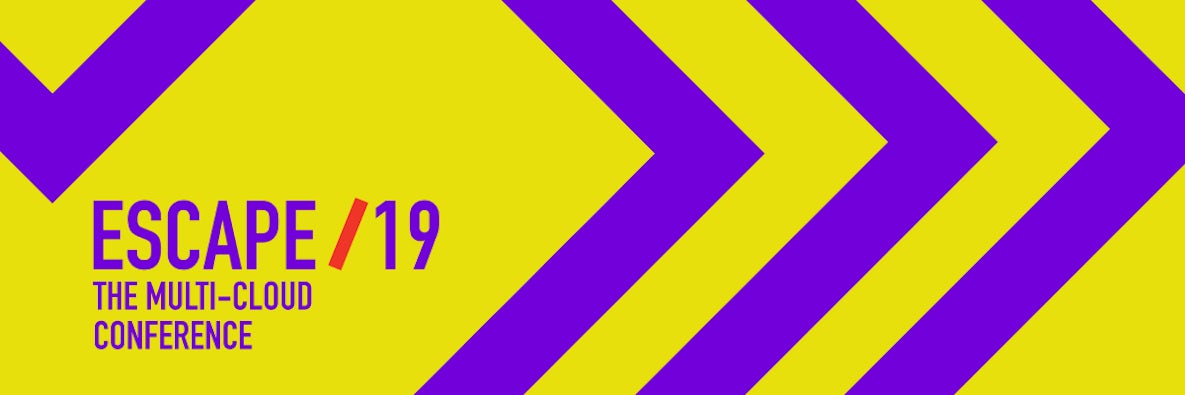
Following his keynote on the big stage at ESCAPE/19 Armon Dadger, CTO and Co-Founder of HashiCorp, sat down with John Furrier of The Cube and said, “If you had this exact same conference 3 or 4 years ago everyone would’ve been like, what Multi-Cloud? Multi-Cloud is not real. And now nobody questions the premise. They’re like, ‘obviously we’re going to be multi-cloud.’”
The inevitability of multi-cloud permeated the speaking sessions at ESCAPE/19 - the inaugural Multi-Cloud Conference hosted in downtown NYC. Technologists demo’d software to navigate the storage, networking, and compute challenges of multi-cloud. Business leaders took the stage to confront the price of multi-cloud deployments, the importance of moving data closer to users, and the business value of multiple vendors.
In stark contrast to the big cloud shows, ESCAPE/19 speakers were encouraged to get into the multi-cloud weeds. On stage, in the breakout rooms, and in the hallway conversations multi-cloud trends took shape. This blog will focus on five trends that emerged and are important to watch as the multi-cloud transition continues to gather momentum.
Multi-Cloud Security Starts at the Kernel Level
“In order to have a true multi-cloud experience we need to start at the fundamental layers and work up.” - Kris Nova, Sysdig
Security is a challenge in multi-cloud deployments. Amazon has great security tools but they’re all irrelevant if you want to move to Google. The challenge that Kris Nova addressed in her talk (and in her work at Sysdig) is how to build an agnostic set of tools that enable security privileges and observability information regardless of which cloud an application is running on.
Sysdig does this by standardizing on the Linux kernel level utilizing cgroups and namespaces. Cgroups (a Linux kernel feature) enable the system admin to define a custom set of rules. If a process tries to break a rule the cgroup will use the kernel to govern what an application can and cannot do. Namespaces work similarly, the difference being that they decide what a process can and cannot access.
Nova explained that if you can audit at the kernel level then you can see the same issues regardless of where an application is running. From the kernel’s perspective, it doesn’t matter if an application is running in a container or on a host.
Tools like Terraform make multi-cloud infrastructure easier by sitting above the clouds and abstracting away some of the complexity caused by the arbitrary differences in the cloud APIs. Kris Nova is making multi-cloud security easier by working way down below the clouds at the kernel.
The Environmental Footprint of the Cloud
“It’s not just about securing the cheapest price.” - Rob Reid, Lush
To begin the second day of ESCAPE/19, Rob Reid gave a thoughtful, data-driven presentation called The Ethical Cloud in which he pointed out the impact that internet consumption has on the planet and the people involved.
The three major cloud providers deliver varying degrees of effort towards achieving sustainability. Amazon, Microsoft and Google each have a webpage dedicated to their sustainability intentions. The TLDR summary is that the rapid growth of companies like Amazon is driving massive investments in fossil fuels (not renewable resources).
Currently, the internet uses roughly 3% of global power consumption and is generating as much emissions as the aviation industry. This is an issue that can only be resolved by powering data centers with 100% renewable resources. While Amazon, and others, are planning to invest more into renewable energy the fact is that “we” the users have to participate in curbing the trend.
Here are four actions that Rob recommends:
- Move to the cloud if you aren’t there already. There are more resources and energy efficiencies available in the cloud.
- Choose your provider carefully. Which ones are working towards increasing renewable energy usage?
- Minimize of over-provisioning - This will reduce the energy used and is more cost-effective.
- Ask questions - Make your cloud provider aware of your concerns.
Microservices Broke the Local Development Experience
“The development experience has gotten a lot worse precisely because of the features of microservices and containers that make multi-cloud possible.” -Ethan Jackson, Kelda
To be clear, Ethan Jackson believes in the direction that multi-cloud is headed. In his talk on stage at ESCAPE/19 he said, “True portability is finally possible. We’re not all the way there yet - but we’re on the path to true multi-cloud.” His chief concern is what the path to true multi-cloud is doing to application developers.
The same microservices that created the portability needed to keep up with continuous deployment also created a poor developer experience. There are more moving parts now than there were in the monolith. The standardization on complex tools means more complex infrastructure. And the transformed tech stack requires that developers have a larger variety of specialized skills. The problem is that we don’t live in a world where every developer knows the entire stack from assembly to front end. For DevOps engineers, Kubernetes is easy. But the application developers that are writing code every day are not interested in containers.
A lot of the increased complexity happens in production. Developers that Ethan has spoken with say that they’re wasting 20-30% of their time fighting the local development environment. Tools like minikube would be helpful but they’re too difficult for most developers. The result is that developers don’t have confidence that the code they’re running will work in development.
Ethan doesn’t see any reason why the development experience with microservices can’t improve over time. The “elite tech companies in San Francisco that have nice cafeterias solve the problem by hiring large teams to build out a development process that’s really smooth.” They solve it by giving each developer a sandbox, a shared kubernetes cluster (managed by DevOps team), a centralized configuration, a simple command-line interface, and instant code synchronization.
The next step is to make that process accessible to developers who don’t work at these elite tech companies.
The Cloud is Getting More Political
“If you are a large enterprise buyer you have to care about politics.” - Zac Smith, Packet
In his talk, “The 5 P’s of Multi-Cloud,” Zac addressed price, performance, proximity, pride, and politics. Politics, he said, is hitting the enterprise hard in the form of data localization regulations popping up all over the globe. What’s interesting about politics is that the impact cannot be predicted or negotiated. If you’re a bank and a government says ‘All your data has to stay in this country,’ you have no choice but to figure it out. Places like Russia, China, Vietnam, India, and South Korea are a few of the 120 countries (and counting) in which there are data localization regulations.
According to the Turbonomic 2019 State of Multi-Cloud study, 83% of infrastructure engineers believe that workloads will eventually move freely between multiple clouds. The fact is that infrastructure engineers need it to move freely between clouds because they’re subject to the whims of politicians and the growing quantity of data storage laws. Unfortunately, this free inter-cloud movement is likely years away. In the meantime, navigating the politics of the cloud means setting up a database that can react fluidly to political whims without compromising business goals or end-user experience.
'Accidental' Multi-Cloud is Pretty Common
“You might say: I’m going to go all-in on Cloud A and then I buy a company that uses Cloud B. Now I’m multi-cloud. The pragmatic reality for the global 10,000 is that you’re going to be a multi-cloud company whether you want to or not.” -Armon Dadger, HashiCorp
This one is for the non-believers. In various talks throughout the two-day event, the concept of “accidental multi-cloud” came up often. This trend began with the maturation of Google Cloud and Azure and has become an inevitable reality for many companies through mergers and acquisitions.
Eric Han from Portworx gave the credit for coining the term accidental multi-cloud to Joseph Sandoval from Adobe Advertising who explained what he meant, “Adobe is buying different companies that may be on AWS (which a lot of us are) or some are on Google Compute Engine. And all of a sudden I have these different entities running on these different platforms - it just kind of happens. And then as leaders, you have to figure out how to make these things work together.”
We built ESCAPE/19 to help people figure out this challenge: how to make multi-cloud work. And as speakers like Armon and Eric pointed out, that challenge is going to apply to everyone in years to come--whether they anticipate it or not.
If you couldn’t make it to the conference, don’t worry - here is a link to all the videos from ESCAPE/19. Hopefully, we’ll see you there next year.
